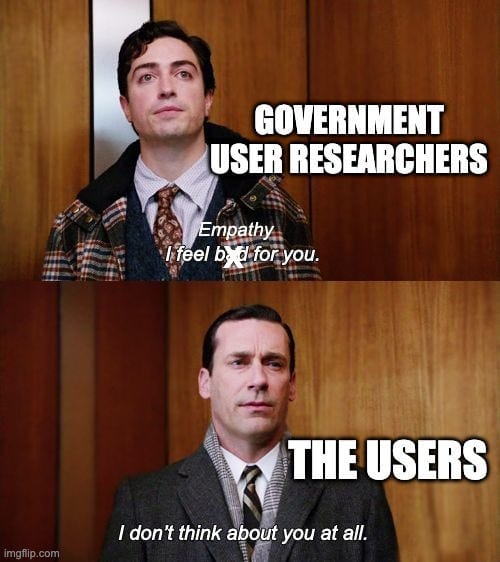I’m a service designer and I’ve never done co-design — here’s why
Spoiler alert: we need to create the conditions to do this work properly

A few months ago, I was asked to talk to a small service design community on the topic of co-design. I rarely turn down invitations to talk to communities about topics I care about so I was leaning toward yes.
But, I had one really big reason to hesitate: I’ve never actually done co-design, at least in the way that I understand co-design should be done (most of what I know about co-design is from KA McKercher who wrote a wonderful book about it.)
I’ve worked on some high-profile problems: Brexit, report a cybercrime, digital identity. But when I reflect back on my work, doing co-design in a meaningful way has never been possible because I’ve never worked in the conditions where this practice could thrive.
I’ve boiled it down to these reasons:
1 — I wasn’t able to share power in a meaningful way
Co-design requires giving people meaningful power over the decisions being made, but I’ve found that by the time I’ve joined a team, either the most critical decisions have already been made by the team, or the people at the top are unwilling/unable to put the the power in the hands of people.
For example, in late 2018 I worked on a team delivering a website to help businesses navigate Brexit. The UK was in a state of extreme uncertainty, and information like this was much needed. This is work that would have been perfect for co-design, except we weren’t involved in crafting the policy that would actually affect those businesses. We were the team putting together the website so they could find the information. The users wanted to feel like their concerns were helping shape the big decisions our government was making but in reality their input went no further than helping us figure out the structure and language of a few webpages.
In this case, and in many cases, the policy is what matters and asking people to co-design a website without being able to influence the policy behind it feels like a lie that gives them false hope that they have control.
Janet Hughes said it well:“Don’t waste people’s time with things that look like co-design if you aren’t really going to act on what you learn” — Source
2 — I didn’t have the time, patience or genuine buy-in
Pretty much all of my teams have been agile delivery teams with a clear destination in mind. Co-design doesn’t fit into two-week cycles, and it cant be approached with a solution in mind. Building trust can’t be timeboxed.
Most service designers I know, at least the ones in government, work on tech problems in agile delivery teams. The ones who don’t work on tech teams work on consultancy basis, where, again, there’s a deadline and usually a final product in mind.
Most government orgs aren’t making the space to approach co-design in a way that is open ended and flexible, so until we are able to reimagine how we work, co-design will continue to be out of our reach.
3 — Sometimes the users of the service don’t really care about the service.
People care deeply about the services that affect them the most: healthcare, community services, social support, immigration and so on.
But, I’m sorry to say, there are many services out there that users just don’t care that much about.
Lately I’ve been working on internal service to help make it easier for public servants to do their job and though I’m finally in a team where I can negotiate the time it takes to slowly and deliberately co-design something with users, there’s a problem: The users don’t want to be involved. They’re busy with their regular jobs. They don’t care about this service as much as I do.
I’ve found that the users I deal with have two needs:
- They want something that works
- They want somewhere to complain when it doesn’t
Beyond that, they don’t want to tell me how to do everything. They want me to figure it out for them, and give them a chance to give feedback after.
If you work on a service where the people who use it are deeply affected and care about the outcomes, I really think co-design is necessary. But for the rest of us, user consultation might be good enough.
In government, we aren’t creating the conditions for true co-design
“Despite our best intentions, co-design can be derailed through a lack of sponsorship, resource(s) or a lack of broader organisational or community commitment” — KA McKercher, Beyond Sticky Notes
Here’s an uncomfortable truth to those of us doing service design in government: Most of us just aren’t set up to do proper co-design. I think this is mostly because government is not set up to share power.
It’s not our fault.
We might not be able to change it.
But we can try our best.
What we can do instead
In the end, I did talk at that service design meetup, but instead of sharing co-design success stories, I talked about all of this and why I felt like I’ve never had the opportunity to do this important work. It seemed to resonate with the audience, and there was quite a bit of discussion on twitter afterwards which makes me think others are experiencing this too.
I wrapped up my talk with these tips on what we can do, when co-design isn’t an option:
- Reflect on what’s missing. What skills, people and resources do you need in place to do co-design effectively? What’s in your control? What’s not?
- Figure out the boundaries of power in your team/org. What decisions or power are you able to put in the hands of your users?
- Make the people you work with feel invested in the experiences of your users. Share stories, bring your team along to research, link user needs to everything you do
- Help your leaders see the value of this work. Show that the risks of not doing co-design are great than the risks of doing it.
- Make it easy for users to contribute. Connect with them in a way that makes sense and doesn’t add unpaid work for them.
- Keep showing up for your users. Showing that you are taking some sort of action goes a long way to building trust.


Comments ()